by Naomi L. | October 4, 2017 | Blog, Creative Writing |
It’s the first week of October, so regular readers of mine, you know the drill: it’s time to dive once again into my all-time favorite story, Romeo & Juliet! In the past, I’ve covered five points in the story that are often missed, the reasons it really is a great love story, a review of the book with both the play and the musical adaptation, and five lessons about love that can be learned from this story. Now I’m ready to cover even more of this timeless classic!
This year, I decided to dig a little deeper into the story and dedicate my annual R&J post to the literary devices that uphold it. So on that note, here are five major themes and motifs in Shakespeare’s Romeo & Juliet. Enjoy!
1) The Power of Love
But my true love is grown to such excess / I cannot sum up sum of half my wealth. – Juliet Capulet (2.6.33–34)
This one is kind of a given, but it’s such a prominent theme in Romeo & Juliet that it forever warrants a place at the top of the list. Though debates reign about the extent of the roles of fate, hatred, and violence in the play, it’s obvious that love is by far the most powerful force in this story. It brings the young lovers together, motivates them to risk everything to be together, and drives them to their tragic end. So let’s explore how powerful love really is in Romeo & Juliet, shall we?
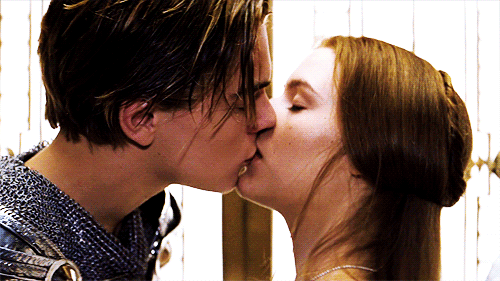
“Then have my lips the sin that they have took.” (1.5.110)
Romeo and Juliet share their first kiss (Romeo + Juliet, 1996)
To start, it’s important to define the type of love that dominates the play. There’s no question that the love in Romeo & Juliet is romantic, but what often gets overlooked is the fact that it’s also amoral. While other poets before him romanticized love as a beautiful and pure emotion, Shakespeare was more interested in portraying it as an intense and violent force that drives people into chaos and overpowers all other priorities, including life itself.
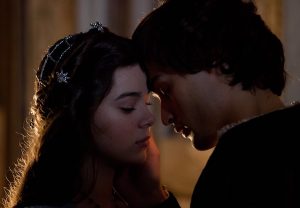
“You kiss by th’ book.” (1.5.112)
Romeo and Juliet find a moment of privacy at the Capulet Ball (Romeo & Juliet, 2013)
The greatest evidence of love’s intensity in Romeo & Juliet is the wide variety of descriptions and metaphors it receives throughout the play. In the sonnet that makes up Romeo and Juliet’s first conversation, love is described in religious terms, while in the prologue of Act II, the feeling is equated to magic. Its dangers are also mentioned by other characters: Friar Laurence warns Romeo about the fickleness of young love, while Mercutio’s Queen Mab speech outright criticizes the delusions of lovers’ dreams. Juliet even loves Romeo so much that she hardly has enough words to express her feelings all at once. Every character in the play seems to have an opinion on love, yet not one of them manages to describe it completely. It seems love, at least according to Shakespeare, is so powerful that it can’t be contained in any one definition.
Though the love in Romeo & Juliet is romantic, it’s far from idealized. Unlike the cheesy version in the bad poetry Romeo recites about Rosaline, Shakespeare’s depiction of love is a far more passionate and chaotic emotion that can evoke an astonishing amount of beauty and tragedy in a short period of time. No wonder this story is still so popular today; every time I read it, there’s something new to learn about love!
2) The Inevitability of Fate
A greater power than we can contradict / Hath thwarted our intents. – Friar Laurence (5.3.153–54)
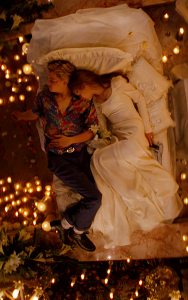
The star-crossed lovers meet their untimely end (Romeo + Juliet, 1996)
If love is the strongest theme in Romeo & Juliet, fate is a close second. From the opening lines of the chorus, it’s made clear to the audience that the young lovers are pretty much doomed from the start. While there is a solid argument that society is really to blame for Romeo and Juliet’s deaths, the fact that Shakespeare peppered his play with references to fate, fortune, and the stars hints at the idea that every circumstance leading up to the main characters’ tragic end was always out of their control.
Notably, the role of fate in this story isn’t just clear to the audience; it’s also evident to the characters themselves. Through the second half of the play, after Mercutio and Tybalt are killed, death always seems to linger in the corner of the lovers’ minds. They’re both haunted by omens—such as each other’s pale faces after spending the night together or Juliet’s vision of Tybalt’s ghost before taking the sleeping potion—and though they try to stave off the looming threat of tragedy, it soon becomes clear that their story can only end in their untimely deaths.
The inevitability of fate is emphasized by the many forms it takes throughout the play:
- The feud between the Capulets and Montagues, which is purposely never explained
- References to fate by the characters – “O, I am fortune’s fool!” (3.1.141), “Then I defy you, stars.” (5.1.24)
- Friar Laurence’s letter failing to reach Romeo
- Romeo dying just before Juliet wakes up
While fate often seems like an external and impersonal divine force driving the characters’ lives, it also manifests as the direct forces influencing Romeo and Juliet’s choices. The rivalry between the noble households culminates in the double murder that complicates the lovers’ marriage, and Capulet’s decision to change the day of the wedding contributes to the rush of events that leads to the final tragedy. Even the protagonists themselves play directly into the hands of fate. The irony of Romeo’s decision to die alongside Juliet is that by trying to defy fate, he inadvertently brings it about: Juliet kills herself as soon as she finds him dead, thus completing the tragic sequence of events set in motion from the play’s very first scene.
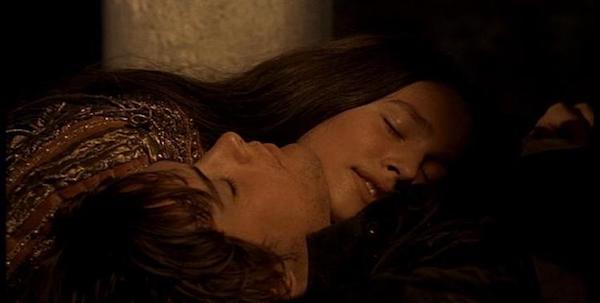
Juliet stabs herself with Romeo’s dagger and dies by his side (Romeo and Juliet, 1968)
Much like love, fate in Romeo & Juliet is an amoral and overpowering force that none of the characters can resist. Despite all their efforts to love each other in peace, Romeo and Juliet can never escape their tragic destiny as the “pair of star-crossed lovers” who “take their life”, immortalizing them as the ill-fated couple of one of the greatest love stories ever told.
3) The Duality of Passion (Love and Violence)
If the entire story of Romeo & Juliet could be summed up in one word, that word would be passion. Almost every scene in the play involves characters succumbing to powerful emotions that drive their actions and, consequently, the plot. Observe:
-
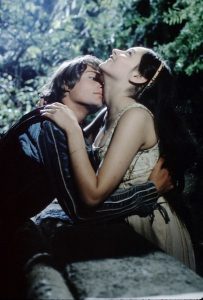
“My bounty is as boundless as the sea, / My love as deep; the more I give to thee, / The more I have, for both are infinite.” (2.2.133–35)
Act I: Montague and Capulet servants fight each other in the street (establishing the long-standing feud), Romeo agrees to attend the Capulet ball for the chance to see a girl he thinks he loves, Romeo and Juliet meet and fall in love at first sight
- Act II: Romeo risks death by trespassing into the Capulet orchard to see Juliet again, Romeo and Juliet declare their love for each other, Romeo proposes to Juliet the next day (via the Nurse), Romeo and Juliet get married
- Act III: Tybalt challenges Romeo to a duel for crashing the Capulet ball, Mercutio fights Tybalt to defend Romeo’s honor, Tybalt kills Mercutio, Romeo fights and kills Tybalt to avenge Mercutio, Romeo almost kills himself out of guilt, Romeo spends the night with Juliet, Capulet threatens to disown Juliet if she doesn’t marry Paris in two days
- Act IV: Juliet threatens to kill herself if Friar Laurence can’t help her get out of marrying Paris, Capulet gets so excited about Juliet becoming obedient that he moves the wedding up to tomorrow, Juliet drinks the sleeping potion Friar Laurence gives her to fake her death
- Act V: Romeo buys poison to kill himself after hearing that Juliet has died, Paris blocks Romeo from entering the Capulet tomb upon assuming he’s there to vandalize Juliet and Tybalt’s bodies, Romeo kills Paris outside the Capulet tomb, Romeo drinks the poison and dies beside Juliet, Juliet wakes up and stabs herself with Romeo’s dagger, Montague and Capulet reconcile over their children’s deaths
Notice how virtually every important action in this play is caused by some intense emotion, whether it’s overpowering love or violent hatred. What’s especially intriguing about the passion in Romeo & Juliet is that love and violence, however polar they may seem, are constantly intertwined. Indeed, the shadow of death hangs over the play’s characters from the prologue to the final scene, and it always manifests as a consequence of passion, as much in love as in hate.
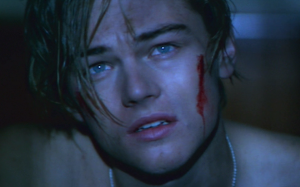
“Ha, banishment? Be merciful, say death.” (3.3.12)
The connection between love and violence in Romeo & Juliet is most evident in the actions and thoughts of the lovers themselves. Both Romeo and Juliet threaten to kill themselves at the first obstacle to their love, each one imagines the other looking dead the morning after their wedding night, and their intensely passionate “star-crossed love” culminates in their double suicide. While their goal is always to keep their love pure, the fact that they both resort to violence to achieve that end supports the story’s major theme of passion as a powerful and blinding force that few can resist.
By all accounts, passion seems to be the cause of all the conflict and grief in Romeo & Juliet. Then again, without passion, there would be no story in the first place, would there?
4) Light and Darkness
More light and light, more dark and dark our woes. – Romeo Montague (3.5.36)

“Gallop apace, you fiery-footed steeds” (3.2.1)
A particularly prominent motif in Romeo & Juliet is the imagery of light and darkness. This motif manifests most frequently in night and day, as much of the action in the play happens either at night or in the morning. And while it doesn’t necessarily highlight any moral statement, the light and dark imagery of Romeo & Juliet does provide an interesting contrast throughout the story.
The most famous example of this imagery is during the balcony scene when Romeo describes Juliet as the sun, being so beautiful and radiant that she has the power to turn night into day. Another well-known example of this contrast is the morning after their wedding night, when the lovers playfully argue about the time of day before Romeo leaves for Mantua. These scenes highlight differing perspectives of the world and emphasize how Romeo and Juliet seek refuge in their love to oppose the reality that threatens to separate them.

“Wilt thou be gone? It is not yet near day.” (3.5.1)
Unlike many other stories that use this motif to symbolize good and evil, the light and darkness in Romeo & Juliet are far more neutral. The lovers favor darkness because it gives them the privacy they desire, yet they see only light in each other. And although it never plays a direct role in their story, the contrast of light and dark does permeate the play until it culminates in a final poetic union: the darkness of Romeo and Juliet’s deaths and the light of hope in their families’ reconciliation.
5) Individuality vs. Social Conformity
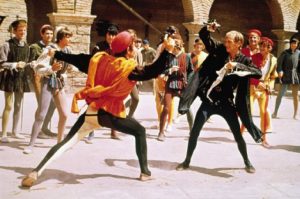
“Alla stoccata carries it away.” (3.1.77)
While love and fate pull most of the strings in Romeo & Juliet, the lives of the main characters are further complicated by the obstacles imposed by their society. Throughout the story, Romeo and Juliet struggle (with varying degrees of success) to defy the social institutions that oppose their love, such as:
- Family and patriarchy
- Religion
- Law and social order
- Masculine honor
Yet despite the challenges they face, the young lovers repeatedly prove that their love is stronger than the social norms that threaten to keep them apart. Juliet defies her father’s authority in order to marry the man she loves and remain loyal to him to the end. Romeo compares Juliet to the sun and considers her more beautiful than the goddess of the moon, while Juliet refers to Romeo as the “god of my idolatry” (2.2.114). While still banished, Romeo returns to Verona to see Juliet one last time before he dies. Romeo refuses Tybalt’s challenge for Juliet’s sake (though he later succumbs to the pressure of honor after Mercutio is killed).
By constantly rebelling against their world, Romeo and Juliet establish themselves as individuals who seek to distance themselves from the obligations their public social lives impose upon them. Yet despite their best efforts to rebel through individuality, these social institutions continue to force them further into a corner until they’re left with only one option for escape. If anything, the greatest tragedy of Romeo & Juliet is that as powerful and beautiful as their love is, they can only find peace from their poisonous society through the ultimate form of darkness and privacy: an eternity together in death.
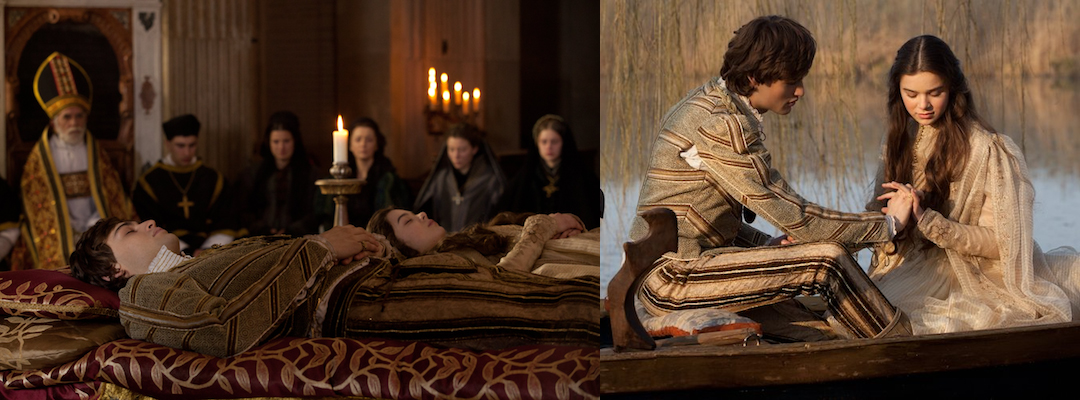
“For never was a story of more woe, / Than this of Juliet and her Romeo.” (5.3.309–10)
What are your thoughts on these themes and motifs in Romeo & Juliet? Any other interesting themes you would add to this list?
by Naomi L. | October 5, 2016 | Blog, Creative Writing, Featured |
Welcome to the first week of October, or as it’s come to be known here on The Wolfe’s (Writing) Den, “Romeo & Juliet Week”! Yes, every year around this time, I like to share a post about my favorite love story: since I started blogging in 2013, I’ve covered five points that are commonly missed, the reasons this is such a great love story, and a book review of Romeo & Juliet / West Side Story.
Now I’d like to continue the trend this year with a post about some of the lessons we can all learn from Shakespeare’s timeless romance. So on that note, here are five lessons about love in Romeo & Juliet! Enjoy!
1) Love is blind.
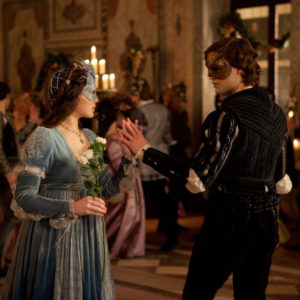
Romeo and Juliet meet at the Capulet Ball and fall in love at first sight (Romeo & Juliet, 2013)
This is arguably one of the most famous lessons taken from Romeo & Juliet (second to, if not tied with, the fourth point on this list). The city of Verona is torn by a feud between two influential households, “both alike in dignity”, yet against all odds, a pair of teenagers from either family find each other and fall in love at first sight. Initially blind to the fact they’re supposed to be enemies, they’re understandably shocked and disappointed after learning each other’s names, but still strive to be together in spite of the hatred that threatens to keep them apart.
Romeo and Juliet’s decision to set aside their differences in favor of romance proves true the famous idiom “love is blind”, and this has become a common theme in many adaptations. A well-known example is the musical West Side Story, in which a Polish-American boy and a Puerto-Rican girl fall in love against a backdrop of racial intolerance and street gang warfare. If there’s one lesson common to all versions of this story, it’s that love is and always will be universal. Be it in social position, race, or anything else, wherever fear and hatred create barriers, love will keep on tearing them down. Which goes to show…
2) Love brings out the best in us.
Too many people focus on the tragic themes in Romeo & Juliet without giving enough credit to the positive points. It’s easy to dismiss the title characters as naïve and misguided teenagers throughout this four-day course of events, but it’s important to keep in mind that they’re very different people by the end of the story than they were in the beginning.
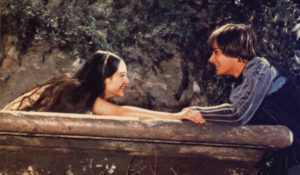
Romeo and Juliet profess their love for each other over Juliet’s balcony (Romeo and Juliet, 1968)
Remember that before Romeo meets Juliet, he quite possibly suffers from depression due to perceived parental neglect and a hopeless infatuation with a young lady named Rosaline. Meanwhile, Juliet before Romeo is the picture of an innocent and sheltered child, pressured by her parents into a marriage of convenience with virtually no freedom to pursue happiness on her own. As I’ve noted before, Romeo & Juliet can be considered a coming-of-age story because after these teenagers cross paths, they quickly blossom into more mature people: Romeo becomes a deeply passionate and devoted lover, Juliet becomes a strong and confident woman, and both are willing to sacrifice everything for the love that makes them the best possible versions of themselves.
Now you may argue that Romeo wasn’t all good inside because he murdered Tybalt, but don’t forget that this act is brought about by his anger over Tybalt murdering his friend Mercutio and has nothing to do with Romeo’s marriage to Juliet. It’s hatred that brings out the worst in this story’s characters, while love only ever brings them happiness and hope for a peaceful future, at least to the ones who are willing to seek it.
Unfortunately, as these young lovers quickly learn, love has a tragic side as well…
3) Life without love is not worth living.
Our idealistic young heroes clearly believed their story was destined to last a lifetime, but sadly, as we all know, it was not to be. In the beginning of Act V, Romeo’s entire world is shattered when he learns that his beloved Juliet is dead (which we know is only part of Friar Laurence’s master plan, but this poor kid missed the memo). Heartbroken, it takes him about a second to decide his next course of action: to drink poison and die at his wife’s side.
Melodramatic, much? Not for someone in Romeo’s shoes. Don’t forget, in the course of a day, this teenage boy lost his best friend, his family, his home, and his social standing, and only narrowly escaped Verona with his life. Juliet was his last ray of hope, and now suddenly, she’s gone too. What else is a grieving young lover, with nothing left to live for, to do but follow his beloved into the afterlife?
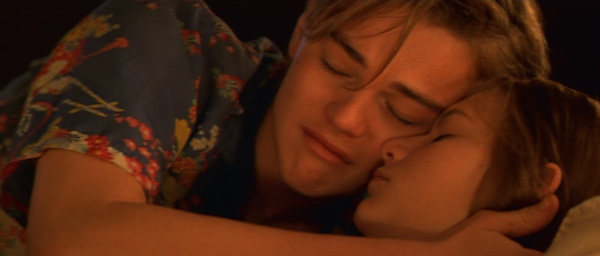
Romeo mistakenly believes Juliet is dead and resolves to die at her side (Romeo + Juliet, 1996)
Romeo’s decision to kill himself only after losing Juliet can be seen as a testament to how much she truly means to him. Even after losing everything else, he holds on to the hope of a future with her, and only gives up on life after that one hope is snatched away. Juliet, in turn, clearly loves Romeo just as deeply, as it also takes her literally a second to choose eternity in death with him over a miserable life alone. The star-crossed lovers are faced with an unthinkable choice in the play’s final scene, yet neither one of them hesitates to die for the other because they already know in their hearts the one truth no one else in the story seems to understand: life without love is not worth living.
Which leads us to the next lesson…
4) Love stories don’t always end happily.
Is there any tragedy in all of literature more famous than the plight of Shakespeare’s star-crossed lovers? Since premiering on stage just over four centuries ago, Romeo and Juliet have become the archetypal young lovers thwarted by fate, a symbol of romance doomed to a tragic end.
After learning of his wife’s supposed death, Romeo ventures into the Capulet tomb to say his final goodbye (“Eyes, look your last. / Arms, take your last embrace.” (5.3.112–13)) and die by Juliet’s side. Upon waking moments later and discovering her husband’s body, Juliet kisses him one last time and promptly plunges his dagger into her heart without a second thought (“O happy dagger, / This is thy sheath. There rust and let me die.” (5.3.169–70)). Fast forward to the Capulets and Montagues grieving for their dead children and the Prince chastising both families for leading these young lovers to their tragic end (“For never was a story of more woe / Than this of Juliet and her Romeo.” (5.3.309–10)).
As prolific readers and writers of romance well know, love stories don’t always end in “happily ever after”. Yet even tragic love stories can still drive home the most powerful message of all…
5) But in the end, love is still stronger than hate.
Romeo and Juliet may not have gotten their happy ending, but the love that compelled them to willingly die for each other still accomplished a miracle: it ended the generations-old feud between the Capulets and Montagues. This may seem like a consolation prize, but it’s still nothing to sneeze at; after all, not even the Prince of Verona could achieve peace between these families!
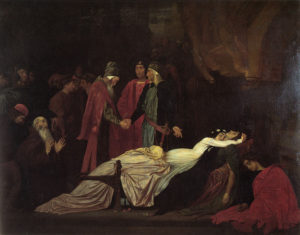
“The Reconciliation of the Montagues and Capulets over the Dead Bodies of Romeo and Juliet”, 1855, oil on canvas painting by Frederic Leighton
One of the central themes of Romeo & Juliet is passion, which manifests equally in love and in violence. Both are powerful and conflicting forces throughout the story, but ultimately, it’s love that conquers hate. To prove this point, compare the deaths of Romeo and Juliet to those of Mercutio and Tybalt. The latter pair engage in a heated duel and both end up suffering violent deaths brought on by anger and hatred; as a result, tensions between the Capulets and Montagues escalate and the feud only gets worse. In contrast, Romeo and Juliet, each the only child and last descendant of their respective families, willingly take their own lives in a final desperate act to escape the violent cycle keeping them apart and be united for eternity. Only then do Montague and Capulet realize their mistakes and make amends, for while they could easily blame Mercutio and Tybalt’s deaths on their enemies, they have no one to blame for Romeo and Juliet’s deaths but themselves.
Romeo & Juliet is one of the greatest love stories ever written, with strong lessons of romance that live on to this day. Whether proving that hatred kills or that love is the most powerful force in the world, Shakespeare’s classic play is a testament to the enduring passions of humanity, and it will always be my favorite story as much for the above lessons as for its ultimate message: life is fleeting, but love is forever.
What about you? What lessons do you think can be learned from Romeo & Juliet? What has this classic story taught you about love?
by Naomi L. | October 7, 2015 | Blog, Creative Writing, Off The Bookshelf |
I know it’s been a while since I’ve shared a book on my Off The Bookshelf segment, so this week, I’m going to discuss one of my favorites. I’ve talked about this famous story in depth a few times before, notably to discuss five points that are often missed and the reasons why it’s a greater story than many people think. Once again, I’d like to revisit this classic tale of forbidden love, this time in a double dose. I hope you’ll enjoy this review of one of my favorite books off my shelf: Romeo & Juliet/West Side Story.
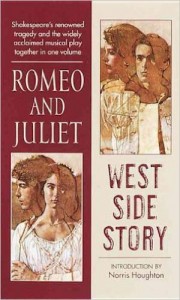
Romeo & Juliet/West Side Story
Summary
First published in 1965, Romeo & Juliet/West Side Story comprises two stories in one: the stage play Romeo & Juliet by William Shakespeare; and the 1957 Broadway musical West Side Story by Arthur Laurents. The book also includes explanatory notes for unfamiliar expressions in Shakespeare’s play and a foreword by renowned theater director Norris Houghton.
Romeo & Juliet tells the story of two teenagers in Renaissance Verona who fall in love despite the age-old feud between their families, but who are driven to an untimely end by fate and the violent circumstances surrounding them. Inspired by Shakespeare’s play, West Side Story tells the same tragic tale of a doomed romance between young lovers, but updates the setting to modern-day New York and the protagonists to a white American boy and a Puerto-Rican girl torn apart by the racism-fueled rivalry between the street gangs with which they’re associated. As much for Romeo and Juliet as for Tony and Maria, love blossoms at first sight and against the odds, only to be threatened and destroyed by hatred that brings tragedy not just to the young lovers, but to their war-torn society as a whole.
Review
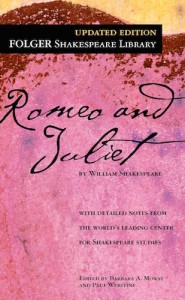 I first read this book as a teenager, shortly after watching the 1961 movie West Side Story as homework for singing lessons (I was to sing “Somewhere” at my first presentation). Long familiar with the plot of the original play, I had fallen in love with the story of forbidden romance and was eager to finally read Shakespeare’s timeless classic for myself. Of course, I’ve made my love for the story itself abundantly clear in the past, so this review will focus a little more on the format of this book than on the pieces within it.
I first read this book as a teenager, shortly after watching the 1961 movie West Side Story as homework for singing lessons (I was to sing “Somewhere” at my first presentation). Long familiar with the plot of the original play, I had fallen in love with the story of forbidden romance and was eager to finally read Shakespeare’s timeless classic for myself. Of course, I’ve made my love for the story itself abundantly clear in the past, so this review will focus a little more on the format of this book than on the pieces within it.
What I find most interesting about this particular book is the way the same story is presented over two very different backdrops: one in Renaissance Italy, the other in 1950s New York. By combining both stories into one volume, Romeo & Juliet/West Side Story offers a unique way to visualize the tale of star-crossed young love across time. The similarities and differences between these popular pieces become clearer as the reader is able to quickly swap a scene in one play for its parallel in the other: the feud between the Montagues and the Capulets becomes a turf war between the Jets and the Sharks, the Capulet ball becomes the dance at the gym, the poetic exchange at Juliet’s balcony becomes a duet on Maria’s fire escape. Each story is beautiful in its own right, but I’ve found that to be able to compare and contrast them so easily makes the fundamental plot all the more fascinating.
 Romeo & Juliet was the first Shakespearean play I ever read, so naturally I was yet unfamiliar with Elizabethan English. This is where the notes in the back of the book came in extremely handy. Essential words and terms are referenced to the line with modern English translations and explanations wherever necessary, so the notes were a tremendous help when it came to deciphering the meanings within Shakespeare’s verse. It’s worth noting that they’re still helpful to any new reader who plans to read more of Shakespeare, as several of the expressions used in Romeo & Juliet commonly appear in his other works. Unfortunately, a similar device isn’t available for West Side Story, which relies on its readers’ familiarity with the music to be fully enjoyable, but this is merely a minor drawback to what is otherwise an equally stunning theatrical masterpiece.
Romeo & Juliet was the first Shakespearean play I ever read, so naturally I was yet unfamiliar with Elizabethan English. This is where the notes in the back of the book came in extremely handy. Essential words and terms are referenced to the line with modern English translations and explanations wherever necessary, so the notes were a tremendous help when it came to deciphering the meanings within Shakespeare’s verse. It’s worth noting that they’re still helpful to any new reader who plans to read more of Shakespeare, as several of the expressions used in Romeo & Juliet commonly appear in his other works. Unfortunately, a similar device isn’t available for West Side Story, which relies on its readers’ familiarity with the music to be fully enjoyable, but this is merely a minor drawback to what is otherwise an equally stunning theatrical masterpiece.
Both Romeo & Juliet and West Side Story have had a profound impact on audiences: one for its poetic deconstruction of romantic ideals, the other for its dramatic commentary on the consequences of social intolerance. The presentation of both plays in one volume brings to light the true timelessness of Shakespeare’s classic, proving that the story of love born against hate will be forever relevant as long as people and society continue to be powerfully motivated by both.
Inspiration
Romeo & Juliet is the archetype of forbidden love thwarted by circumstance, so it’s no wonder the story has translated so well into the modern setting of West Side Story. Whether set between feuding families or warring street gangs, this tragic love story reads not only as the epitome of the passion and dangers of young romance, but as a lesson on how hatred kills. Perhaps for its universal themes of love, intolerance, and the cruelty of fate, the plight of the star-crossed lovers is a tale that has fascinated readers for centuries and certainly will for many more to come. It has served as inspiration for much of my romantic fiction, and to this day I indulge in it whenever I feel the need to satisfy my cravings for drama and romance.
For all the above reasons and more, Romeo & Juliet is and likely always will be my favorite story at its core, regardless of the characters, settings, and details that flesh it out. To be able to enjoy my two favorite versions of the story in a single volume is simply the cherry on top of a classic poetic delight.
by Naomi L. | October 8, 2014 | Blog, Creative Writing, Featured |
A year ago tomorrow, I shared a post on five points that are often overlooked in William Shakespeare’s timeless play, Romeo & Juliet. Now I’m back and inspired to strongly defend it a second time. Nowadays, it’s “cool” to criticize this story and dismiss it as a silly tale about two naïve infatuated teenagers whose irresponsible actions cause the deaths of six people, themselves included. I know because I used to be one of said critics. Since recently starting to learn more about this play, however, I’ve come to the conclusion that people need to stop being so cynical and start making an effort to appreciate the story Shakespeare was really trying to tell.
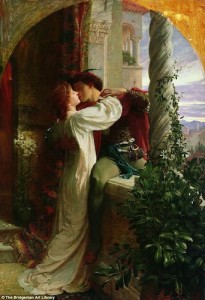
“Romeo and Juliet”, 1884, oil on canvas painting by Frank Bernard Dicksee
Fortunately, there are plenty of people who do understand what Romeo & Juliet is really about and who are more than willing to share their opinions on it. If you want to discover the real meaning of this story, start by following the “Defending RJ” tag on Tumblr. RomeoandJulietFan’s blog is also a must-read, as she does an excellent job of curating the best content defending this play. There are plenty of good points to be made on this side of the debate, but most arguments cover the same basic few.
So in the interest of revealing the true depth of this classic tale, today’s topic once again covers some important points often missed in my favorite Shakespearean play. Enjoy!
(Warning: the following post contains possible spoilers for Romeo & Juliet. If you’re one of the few people on the Internet who are not familiar with this tragic story, proceed with caution. Or you can just read a full summary of the plot here.)
True Love or Teen Fling?
This question seems to be at the heart of most R&J arguments, and understandably so. Still, it hardly makes sense to criticize a key element of a 16th-century play by 21st-century standards. While today it may seem silly to think two people can truly fall in love at first sight, remember that Shakespeare wrote his plays at a time when people thought fate was controlled by the stars and instant love was believed to be normal. It’s entirely possible that he did intend for his adolescent protagonists to be soulmates and for their love to be seen as genuine. There are several clues in the text to support this (one of my favorites being how the lovers’ first conversation reads as a sonnet), but the only way to know for sure would be to ask the playwright himself, so there may never be a definite consensus. It all comes down to interpretation.
So were Romeo and Juliet really in love, or did they just share a fiery passion that was doomed to burn out? This is the major point that most people miss: it doesn’t matter. Romeo & Juliet is a tragedy because whether their marriage was a testament to eternal love or a mistake made in the heat of the moment, they never got to find out. Had they lived in a different time or place where they didn’t constantly have to circumvent hostility, they could have been free to let their relationship run its course, however it might have played out. Instead, they meet an untimely end after an unfortunate mix-up forces them to make an unthinkable choice between (so they believed) facing life alone or being together eternally in death. Whatever their relationship was or could have been, it ended far too soon.
Which brings me to the next point…
Romeo & Juliet condemns Hate, not Love!
It baffles me how so-called R&J haters tend to blame the main characters for all the tragedies that unfold throughout the story (which I admit is ironic, given that I used to do the same). RomeoandJulietFan highlights this point perfectly in one of her rants: somehow everyone forgets that all the violence is a continuation of a feud established in the very first scene of the play, and not the fault of a couple of teenagers who were actually the only people from either family trying to escape the rivalry. Yes, Romeo and Juliet do make some poor choices themselves, but judging the completely natural impulsiveness of young people while excusing the irrational and destructive enmity of adults? Come on.
Now don’t get me wrong; in no way am I condoning the romanticization of teen suicide. But technically neither was Shakespeare. The message that should be taken from Romeo and Juliet’s deaths isn’t that lovers in a forbidden relationship should kill themselves, nor that teenagers who would willingly die for each other are stupid. It’s that hatred kills.
Think about it: none of the events leading up to the final tragedy would have happened if the Capulets and the Montagues had just gotten along from the start. Romeo and Juliet wouldn’t have had to keep their relationship a secret, Mercutio and Tybalt wouldn’t have died fighting for their houses’ honor, Friar Laurence wouldn’t have had to concoct the escape plan that failed, and these poor children never would have ended up in the depressing situation that drove them to suicide. By this logic, there’s only one conclusion that can be drawn from the plight of Romeo and Juliet: their families killed them.
So no, the real fools of the story are not the misguided teenagers who chose to pursue love against impossible odds. They’re the adults who should have known better, who should have invested their energy in lovingly raising their children instead of prolonging a feud that, as far as we can tell, had no justification to begin with. Not once throughout the entire play do we see Romeo directly interact with his parents; in fact, his only on-stage relationship with an adult is with Friar Laurence. Likewise, Juliet’s closest parental figure is her nurse, while the few conversations in which we ever see her parents express concern for her always have to do with marrying her off (to a complete stranger, no less). Even the friar and the nurse are guilty of making bad decisions, the former hatching high-risk plans that endanger the lovers’ lives and the latter abandoning her surrogate child in her hour of greatest need. However reckless the young protagonists may have been, it isn’t fair to criticize their poor judgment when it’s clear in the end that no one was there to protect them, whether it was from the feud or from themselves.
Taking all this into account, it’s actually quite amazing how greatly Romeo and Juliet contrast with every other character in the story. So perhaps we shouldn’t be focusing on their flaws so much as on their strengths…
Meet the real Romeo Montague and Juliet Capulet
R&J Hating 101 says that for every criticism of a bad decision made by one of the title characters, at least one reference must be made to their extreme youth. Yes, Romeo and Juliet were young, arguably too young for their story to have played out any other way. If you’ve jumped on this bandwagon, you’re no doubt overly familiar with the phrase “They were just kids!”, perhaps even having used it yourself.
Well, guess what? You were a kid once too. There was a time when you too believed that love could conquer all, that there might be one perfect person out there for you and if you found them, everything in your life would magically fall into place because destiny said you were supposed to be together forever. The major flaw in the logic behind R&J bashing is that the very trait for which the main characters are criticized is precisely what makes them realistic and relatable. Romeo and Juliet behaved exactly as would be expected of people their age, and if you can’t for one second imagine yourself in their place and sympathize with these idealistic lovers, then frankly I feel sorry for you.
So now that we’ve established that Romeo and Juliet were young, naïve and impulsive (i.e. normal teenagers), let’s take a closer look into the iconic characters Shakespeare so carefully constructed.
Romeo Montague is the literary epitome of the passionate lover. This is clear from his introductory scene, which already has him reciting romantic poetry and lamenting over an unrequited love. Yes, he claimed to love a girl named Rosaline before he fell for Juliet, but as I’ve pointed out before, this switch is important to demonstrate the difference between an infatuated boy and a young man in love. It also gives us an insight into his most defining characteristic: he loves to love. The fact that Romeo grew up surrounded by hatred and still chose to pursue romance above all else speaks volumes of his inherently good nature, and that alone entitles him to a little credit, even admiration.
Some character analyses point out that Romeo’s intense love for Juliet is an extension of his tendency to exaggerate emotion altogether, and it’s this for which he’s usually berated by critics. True, he should not have let his rage over Mercutio’s death drive him to murder Tybalt, nor should he have been in such a hurry to die after hearing the news of his wife’s “death”. Yet one must ask: if Romeo had not been such an emotional person, would his war-abolishing affair with Juliet ever have happened in the first place? Of course we shouldn’t condone his terrible choices, but we should at least acknowledge that he’s a well-rounded character whose personality consists equally of virtues such as loyalty, courage and honesty. The complexity of Romeo’s character is what makes him such a solid pillar of one of the most enduring love stories ever written… as is the case of his complementary “other half”.
Juliet Capulet undoubtedly undergoes the most substantial development of any character in the story. Of all the misinformed comments I ever used to make against this play, the most embarrassing is by far mistaking this brave young woman for a foolish submissive child. Much like Romeo, Juliet is established early on as an independent thinker by showing no interest in the same matters as her family (in her case, marriage). Unlike her lover, however, she tends to be more rational and does not let her emotions completely drive her actions, which is actually quite outstanding for a teenager in love.
Juliet is only thirteen, yet people judge her decisions as though she should have made them with the experience of a woman three times her age. Hardly anyone seems to recognize how impressive it is that a girl that young is clever enough to pull an older boy out of his romantic illusions and into a serious commitment. Within the first few minutes of meeting Romeo, Juliet already calls him out on his clichés with a shrewd “You kiss by th’ book” (1.5.114) and consequently inspires in him some of the most iconic love poetry in the history of English literature. Also notice in the famous balcony scene (Act II, Scene II) that Juliet does not let her profound love for Romeo blind her into wholeheartedly accepting his declarations of love, but instead challenges him to prove his devotion by marrying her. Her decision to reunite with her husband after his banishment is not made in haste; however reckless you think she may have been, you can’t deny it takes remarkable courage to give up the security of family and social status in order to pursue happiness. Even Juliet’s suicide takes more daring than Romeo’s (stabbing being far more painful than poisoning), yet she remains loyal to him until the very end, never doubting for one second that her rightful place is eternally by his side.
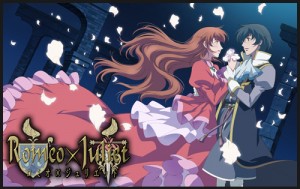
The star-crossed lovers as they appear in the anime adaptation, Romeo x Juliet
From my interpretation, Romeo and Juliet are a good match because they complete each other; Romeo is passionate and loyal, while Juliet is levelheaded and astute. As RomeoandJulietFan points out, the main characters likely connected so well because they were each exactly what the other needed at the time of their meeting. They were not simply hormonal teenagers acting out of lust; otherwise they could just as easily have given in to desire instead of getting married, or gone their separate ways at the first obstacle that forced them apart instead of striving to be together even in death. You can choose to believe it wasn’t true love, but you can’t say that what Romeo and Juliet had was anything but genuine.
Romeo & Juliet is far from an idealized love story, but that’s exactly the point. Young passion thwarted by circumstance is unquestionably the central theme of the play, and one can’t hope to appreciate Shakespeare’s beloved creation without making an effort to fully understand the intricate tale of star-crossed love that, 400 years after premiering on stage, still stands as a highly relevant theme in today’s artistic culture.
And if you still need convincing that all the hate around Romeo & Juliet is unjustified, do yourself a favor and read this post. It pretty much says it all.
I hope you’ve enjoyed reading about these important points of Romeo & Juliet! As you can see, this play is one of my favorites for several reasons, and I defend it in the hope that others may come to love it as much as I do. If you weren’t already, I hope I’ve made a Romeo & Juliet fan out of you! Thanks for reading!
References/Further Reading
by Naomi L. | April 23, 2014 | Blog, Creative Writing |
At last, the time has come for the final chapter of my story. Wondering what you’ve missed? For the past several weeks, I’ve been telling the story behind a “novel” I recently published online: a fanfiction titled Chaos and Control. Part 1 is about the idea for the story, Part 2 is about the planning, Part 3 is about the writing, Part 4 is about the editing, Part 5 is about the publishing, and Part 6 is about the feedback. Have fun reading the last part of the story!
Part VII: The Lessons
In the interest of keeping this post brief, today’s topic will simply be a review of the lessons taken from my fanfiction that I believe can apply to the experience of writing a real novel. Enjoy!
What I learned from Chaos and Control:
 1) When an idea grows in your mind to the point where it starts to consume you, chances are it’s worth turning into a story. Don’t ignore it; embrace it, shape it, bring it to life.
1) When an idea grows in your mind to the point where it starts to consume you, chances are it’s worth turning into a story. Don’t ignore it; embrace it, shape it, bring it to life.
2) Planning is important, but it isn’t everything. The skeleton of a plot and a handful of ideas are great to start with. After that, just write, and let the story surprise you as you flesh it out.
3) Serious writing takes serious commitment. If you ever want to finish that novel, work on it every single day. No excuses; just do it.
4) Well-developed characters will write themselves. When stuck, start writing purely from instinct and see where the characters go on their own. They’ll probably take the story in the right direction.
5) Editing takes just as much effort as writing, if not more. Do not assume your first drafts are perfect; it’s more than likely they’ll require a lot of polishing before they’re worthy of publication.
6) Your technique may change over the course of the writing process. Don’t neglect to revise the entire novel to make sure the style of the first chapters matches that of the last ones.
7) Details and tropes are fun to place, but they’re worthless without a strong storyline to hang on. The most important parts of the story should be the core elements of plot and character development.
8) Never underestimate the importance of marketing and networking. Your novel isn’t likely to draw many readers if nobody knows it exists.
9) Don’t be surprised if your novel doesn’t get as much attention as you’d like, but don’t be discouraged either. If your story can inspire one reader, then it was worth writing.
10) Not everyone will notice the details in your story, but don’t let that get you down. As long as you placed them well, someone is bound to appreciate them.
11) Know your audience and trust their opinions. Feedback from readers is invaluable not only for the current piece, but for any future pieces you may write.
12) The type of story doesn’t make it more or less special than the others you write. As long as you pour your heart and soul into it and receive a valuable experience in return, any story is worth writing.
This concludes the story behind my fanfiction. I hope you’ve enjoyed following my experience with Chaos and Control, and that you’ve found the story behind it as enlightening as I did. If you haven’t yet, feel free to comment with your thoughts. Otherwise, have fun applying these lessons in your writing, and best of luck with your own novels! Thank you for reading!
Note: If you’re interested, you’re more than welcome to read my story and even leave some reviews. I promise you don’t need to know too much about the Sonic universe to appreciate it. Reviews are positive, but contain spoilers! Thank you!
















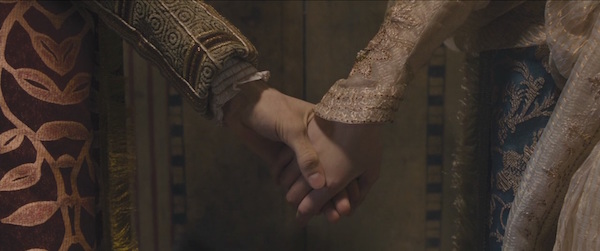




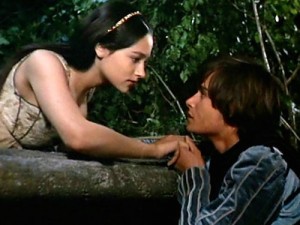
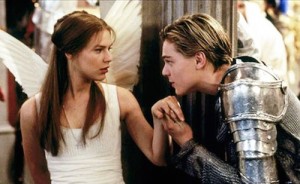
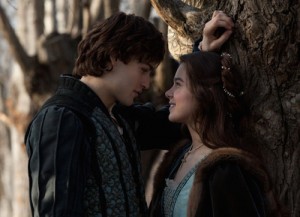




Recent Comments